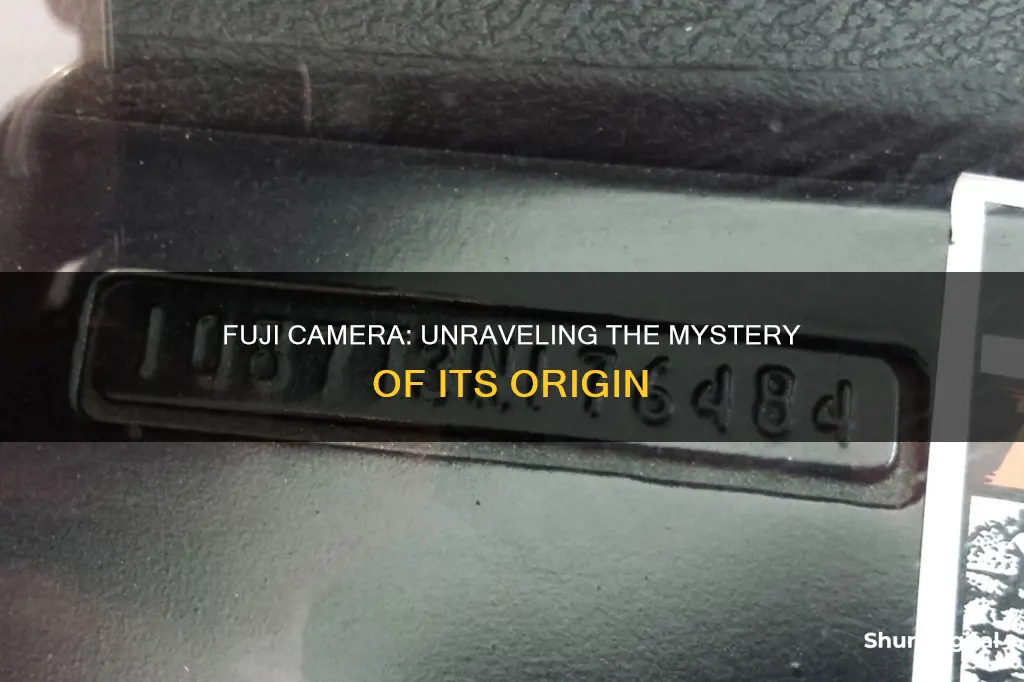
The history of Fujifilm, a renowned camera brand, spans nearly a century. The company was founded in 1934 as Fuji Photo Film Co., Ltd. in Japan, and it initially focused on producing photographic film and paper. In the 1940s, Fuji entered the optical glasses, lenses, and equipment markets. The company began producing cameras in 1948 with the Fujica Six, and many of its cameras until the late 1970s were called Fujica, a contraction of Fuji and camera. In 1988, Fujifilm started producing digital cameras, and in 1994, it entered the digital SLR market. So, depending on the model of your Fuji camera, it was likely made sometime between the late 1940s and the present.
| Characteristics | Values |
|---|---|
| Company Name | Fujifilm Holdings Corporation |
| Trading Name | Fujifilm |
| Type of Company | Japanese Multinational Conglomerate |
| Headquarters | Tokyo, Japan |
| Area of Operation | Photography, Optics, Office and Medical Electronics, Biotechnology, and Chemicals |
| Date of Establishment | 20 January 1934 |
| Founder | Asano Shūichi |
| Original Name | Fuji Shashin Film K.K. |
| Parent Company | Dai-Nippon Celluloid K.K. |
| Product | Photographic Films |
| Current Position | Leader in Camera Technology |
| First Foray into Camera Manufacturing | 1948 with the Fujica Six |
| First Digital Camera | 1988 |
What You'll Learn

The first Fuji camera, the Fujica Six, was released in 1948
The first camera produced by Fuji, known as the Fujifilm Corporation, was the Fujica Six, released in 1948. The company was founded on 20 January 1934, as Fuji Shashin Film K.K., and initially produced several types of film. The name "Fuji" was chosen by the company's first CEO, Asano Shūichi, because of its proximity to Mount Fuji.
The Fujica Six was a 6x6 folding viewfinder camera, with a horizontal folding door that revealed a self-erecting leaf shutter and lens. The first version of the camera came with a Lotus leaf shutter, with a top speed of 1/200, and an f/4.5 triplet lens. The Fujica Six was a simple and compact camera, with a single button that served to open both the front and the viewfinder. The film was inserted on the right and advanced to the left, with a red window to check the exposure numbers.
The Fujica Six was followed by several improved models, including the Fujica Six IIBS in 1950, which featured a rigid optical viewfinder and a shutter synchronized for flash. The Fujica Six series was upgraded in 1955 with the release of the Super Fujica-6, which added a coupled rangefinder, a contoured stainless top plate, and improved lens and shutter combinations.
Japan-Made Cameras: A Comprehensive Brand Guide
You may want to see also

Fuji started making digital cameras in 1988
The Japanese company Fuji, or Fujifilm, started making digital cameras in 1988. The company was founded on 20 January 1934 as Fuji Shashin Film K.K., a subsidiary of Daicel, and it produced photographic films. In the 1940s, Fuji Photo entered the optical glasses, lenses and equipment markets. In 1948, the company diversified into cameras with the Fujica Six. Until the late 1970s, many cameras made by Fuji were called Fujica, a contraction of Fuji and camera.
In the 1980s, the company expanded its production and other operations internationally. During this period, Fuji Photo developed digital technologies for its photography, medical, and printing sectors. This led to the invention of computed radiography (CR), which reduced radiation exposure for technicians and patients.
In 1988, Fuji revealed the world's first "fully" digital camera at the Photokina show in Germany. Called the FUJIX DS-1P, it was the first camera to save data to a semiconductor memory card. The card, developed with Toshiba, had 2 megabytes of SRAM and could hold between 5 and 10 photographs.
The following year, Fuji released the world's first commercially-produced digital camera, the FUJIX DS-X. Today, the company makes digital APS-C and medium format mirrorless interchangeable-lens cameras and fixed-lens compact cameras, all under the Fujifilm name.
How to Extend Your Camera's Battery Life
You may want to see also

The world's first fully digital camera was a Fuji
The world's first fully digital camera was indeed a Fuji. Known as the FUJIX DS-1P, it was unveiled at the 1988 Photokina show in Germany. This camera was the first to save data to a semiconductor memory card.
The FUJIX DS-1P was a groundbreaking innovation in the world of photography. It captured images using a 400 kilopixel CCD (Charge-Coupled Device) that Fuji had started developing in the 1970s. While the first digital camera was invented in 1975 by Steve Sasson at Kodak, Fuji's camera was the first "fully" digital camera. This distinction is important because, before the DS-1P, electronic cameras stored images on magnetic media like video floppies, which had limited data capacity and could result in scrambled or defective photographs.
Fuji's new camera addressed these issues by adopting a digital format and using semiconductor memory cards for storage. This was a bold move, as semiconductor memory was extremely expensive at the time. However, Fuji anticipated that the cost of this technology would decrease and that higher-performance image sensors and compression technology would become available. This foresight led to the creation of the world's first fully digital camera.
The FUJIX DS-1P could capture and store between 5 and 10 photographs on a 2-megabyte SRAM card developed with Toshiba. While the camera was a prototype and never mass-produced, it paved the way for the FUJIX DS-X, the world's first commercially produced digital camera, released by Fuji in 1989. This camera continued the company's legacy of innovation in digital imaging, solidifying Fuji's place in the history of photography.
The Best Ways to Store Camera Batteries
You may want to see also

The company was founded in 1934
The company behind Fuji cameras, Fujifilm Corporation, was founded on 20 January 1934 as Fuji Shashin Film K.K. (later translated as Fuji Photo Film Co., Ltd.), producing several types of photographic film. It was an offshoot of Dai-Nippon Celluloid K.K., founded in 1919. The company's first CEO was Asano Shūichi.
The plants were located in the village of Minami-Ashigara (now a city) in the prefecture of Kanagawa, at the foot of Mt. Hakone. It is said that the name "Fuji" was chosen by Asano Shūichi because of nearby Mt. Fuji, but the name was already registered by a third party. The rights were bought for ¥8,000, a significant sum at the time.
During the early 1940s, the company started to produce optical glass for military use. In 1944, the dependent company Fuji Shashin Kōki K.K. (meaning "Fuji Photo Optical Co., Ltd.") was founded from the assets of Enomoto Kōgaku Seiki Seisakusho, but this was absorbed back into Fuji Shashin Film after 1945. Many other Fuji companies were created after the war, all of them dependent on the main Fuji Shashin Film company and, eventually, the Fujifilm Group.
In the 1940s, Fuji Photo entered the optical glasses, lenses, and equipment markets. In 1962, Fuji Photo and UK-based Rank Xerox Limited (now Xerox Limited) launched Fuji Xerox Co., Ltd. through a joint venture.
Fuji began producing cameras in 1948 with the Fujica Six. Until the late 1970s, many cameras made by Fuji were called Fujica, a contraction of Fuji and camera. The company started producing digital cameras in 1988.
HDR Mode: How Cameras Capture Stunning Images
You may want to see also

Fuji is a Japanese company
The company began as a manufacturer of photographic films, with its roots tracing back to 1919 as an offshoot of Dai-Nippon Celluloid K.K. Over the years, Fuji expanded its operations and diversified its product offerings. In the 1940s, the company entered the optical glasses, lenses, and equipment markets, solidifying its presence in the optics industry.
Fuji's journey into camera production began in 1948 with the introduction of the Fujica Six. For nearly three decades, many of the company's cameras carried the name "Fujica," reflecting its association with cameras and photography. During this period, Fuji established itself as a prominent camera brand, competing with other well-known names in the industry.
In the 1980s, Fuji underwent a notable rebranding, simplifying its name from "Fuji Photo Film Co., Ltd." to "Fujifilm Corporation." This change signaled the company's evolving identity and growing recognition as a leader in imaging technology. The new branding also aligned with the company's expansion into international markets, as it established a stronger global presence.
Fuji demonstrated its adaptability and commitment to innovation by venturing into digital imaging. The company started producing digital cameras in 1988, becoming a pioneer among film makers in embracing the digital revolution. This strategic move positioned Fuji at the forefront of the industry, offering advanced technology in smaller digital consumer cameras with high-sensitivity CCDs.
Today, Fuji, often referred to as Fujifilm, continues to thrive as a multinational conglomerate. While it still produces photographic films, the company has diversified even further. Its product portfolio now includes medical imaging and diagnostics equipment, cosmetics, pharmaceutical drugs, biotechnology solutions, and more.
Fuji's journey from its beginnings as a film manufacturer to becoming a diverse Japanese conglomerate showcases its resilience, adaptability, and ability to stay relevant in a rapidly evolving market. The company's rich history and ongoing contributions to the world of photography and beyond have solidified its place as an iconic Japanese brand with a global reach.
Charging Your SeaLife Camera: A Step-by-Step Guide
You may want to see also
Frequently asked questions
Fuji, or Fujifilm, started producing cameras in 1948 with the Fujica Six.
Fuji began making digital cameras in 1988, with the FUJIX DS-1P, the world's first "fully" digital camera.
The corporate name was changed from Fuji Photo Film Co. Ltd. to Fujifilm Corporation sometime before 2006.
Fuji started making mirrorless cameras in the 2010s with the introduction of the X Series.
Fuji was founded in 1934 as a film manufacturer.







